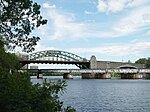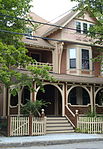Hastings Square Historic District

The Hastings Square Historic District is a historic district that encompasses Hastings Square, a small city park in Cambridge, Massachusetts, and the residential properties that abut it. The houses that line the streets across from the park are among the finest Queen Anne houses in the city. These properties were built between 1869 and 1892, and include two houses known to be designed by architects. The Queen Anne/Shingle style house at 302 Brookline Avenue was built in 1887 to a design by Rand & Taylor, and the 1892 Queen Anne house at 75 Henry Street was designed by Hartwell and Richardson.The district was added to the National Register of Historic Places in 1982.
Excerpt from the Wikipedia article Hastings Square Historic District (License: CC BY-SA 3.0, Authors, Images).Hastings Square Historic District
Hastings Square, Cambridge Cambridgeport
Geographical coordinates (GPS) Address Nearby Places Show on map
Geographical coordinates (GPS)
| Latitude | Longitude |
|---|---|
| N 42.356388888889 ° | E -71.11 ° |
Address
Hastings Square 5
02139 Cambridge, Cambridgeport
Massachusetts, United States
Open on Google Maps









